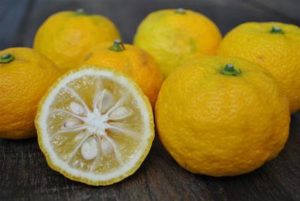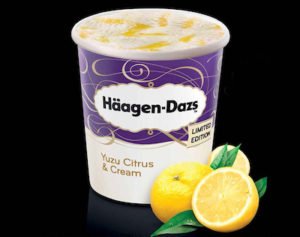The Asian Fruit with a New American Address: Yuzu
(Gerry Furth-Sides) Today’s sexiest fruit, the darling of chefs,” is how our favorite food writer of fruit, UC Riverside pomologist, David Karp, labeled it — five years ago. He described the yuzu as” a rare, expensive Japanese citrus of mysterious provenance.”
Officially the (Citrus Junos (Rutaceae)) the yuzu’s tart and grapefruity flavor has overtones of Mandarin orange. As he presented a variety of the oddest shapes of the yuzu to the Central Library to the Southern California Culinary Historians, Karp extolled, “The Yuzu has anntense citrus perfume that sings through the room. Smells like every citrus you’ve ever smelled combined into one.”
A hybrid of a primitive citrus and sour mandarin orange, the yuzu originated in China, where it grows wild in central China and Tibet. Once it was introduced to Japan and Korean during the Tang Dynasty, they took it over.
Rarely eaten as a fruit because of its sour flavor, Asian chefs season with yuzu almost like western cuisines use lemon’s citrusy essence. The rind is most commonly used to flavor various dishes such as vegetables, fish or noodles while the fruit itself is most often found in bottled juice or dry, powdered yuzu. Yuzu trees were unofficially introduced into California before 1888, grown in home gardens by Japanese-American aficionados. It took another century to bring the fruit to market publicly.
One reason was to “protect” American growers from diseases prevalent in Asian groves. Fresh yuzu still cannot legally be imported into the United States. So about 15 years ago, enterprising farmers started raising yuzu for commercial purposes, some perhaps illicitly, to fulfill a demand from chefs. Because of its scarcity, the yuzu fetches high prices, $8 to $20 a pound wholesale, and up to twice that at retail. Wholesalers tend to be secretive about sources.
So it’s not surprising that few diners have seen this puckered little pseudo golf ball up close, or even heard of it. Still, more and more are experiencing its distinctive flavor and aroma, a complex blend of lime, lemon, and grapefruit.
But never fear, affordable local Asian restaurants also use it creatively yuzu zest and juices in a variety of cocktails, savory and sweet dishes. Still, fresh and processed yuzu is the rage in restaurant kitchens for cocktails, savory dishes, and sweets. “Yuzu is less sharp and more subtle than lemon, allowing its fruitiness to come through,” explained Wylie Dufresne, the chef and an owner of WD-50.
As Slow Fish Restaurant’s sought-after Japanese sushi chef laughed,” it may be new to America, but we’ve been playing with it for 3000 years.”
The yuzu (you-zoo)’s citrusy flavor is more subtle than lemon with an astonishingly intense floral citrus fragrance and nose hint of Mandarin orange. Trying to identify the aroma drove me crazy in the Signature Slow Fish appetizer. The chef drizzled a ponzu, rich with pungent yuzu, over carved cucumber slices each center filled with a mosaic of asparagus, avocado, salmon, and crab.
Typically restaurants use yuzu to accompany fish but yuzu also stars as dessert. At Spago in Beverly Hills, Pastry Chef Sherry Yard used to make yuzu meringue tarts as well as pineapple-yuzu sorbet. Shiloh Steakhouse serves them in lush merengue tarts.
“Yuzu has an amazing floral citrus fragrance — you can smell it from across the room,” said Gregory Brainin, chef de cuisine at the toney Jean Georges in New York, who served 30 different yuzu recipes as long as a decade ago. For one dish, the captain suffuses bay scallops with a mist of yuzu juice sprayed with an atomizer he carries to each table.
There are now recipes galore for yazu, both savory and sweet dishes. Here are a the top ten from Yummly.com
Rarely eaten as a fruit because it so sour, Korean and Japanese chefs use zest as a garnish for a savory custard dessert with its zest. Asian chefs also use its juice as a seasoning the way western chefs use lemon. At SLOWFISH in Huntington Beach, Chef An adds Yuzu to the citrus-based sauce ponzu and in their shoju (Asian vodka) cocktails.
Fresh yuzu is available intermittently in season at Japanese markets. Other times look for yuzu juice, salted and unsalted; frozen fruit; dried peel; and kosho, a paste of yuzu rind macerated with hot peppers and salt.
Trader Joe’s Canadian growers know that thinly sliced, sweetened Yuzu sweetening makes for a terrific, thick marmalade, laced with the chopped rind. Instead of the usual Asian chef use of sugar and honey; Trader Joe’s “Citron Spread” label reads healthy grape juice, lemon peel, natural fruit pectin. A tablespoon of this marmalade stirred into a cup of hot water makes Yuja cha, a healthy herbal tea known the cure the common cold.
For a citrusy and spicy hot sauce, Yuzu is perfect. Trader Joe’s carries it.
 Not convinced to try eating it? There are alternatives. Ripe golden yuzu symbolizes winter in Japan, where the custom on the winter solstice is to bathe with floating whole aromatic fruits wrapped in cheesecloth. Or play a traditional Asian oboe- it’s made from yuzu wood.
Not convinced to try eating it? There are alternatives. Ripe golden yuzu symbolizes winter in Japan, where the custom on the winter solstice is to bathe with floating whole aromatic fruits wrapped in cheesecloth. Or play a traditional Asian oboe- it’s made from yuzu wood.
Slow Fish www.slowfish.com; Zu Robata, www.zurobata.com; Izayoi www.izayoi.com








 Gerry Furth-Sides
Gerry Furth-Sides  Barbara Hansen
Barbara Hansen  Chef-owner Alain Cohen
Chef-owner Alain Cohen  Roberta Deen
Roberta Deen  Jose Martinez
Jose Martinez  Nivedita Basu
Nivedita Basu